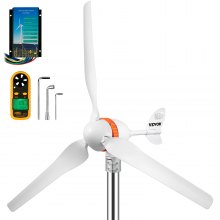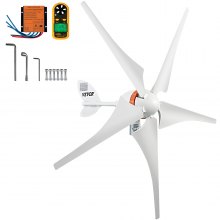A Visual Journey Through the Aesthetics and Design of VEVOR’s Wind Turbines
In the quest for sustainable energy solutions, wind power stands out as a beacon of hope, harnessing the inexhaustible power of the wind to generate electricity.
VEVOR’s wind turbines present a captivating spectacle at the intersection of form and function. Each turbine is a testament to the marriage of innovative design and eco-conscious engineering, exemplifying the company's dedication to efficiency and aesthetics. From the graceful sweep of the blades to the sleek contours of the turbine housing, every aspect of VEVOR's design ethos speaks to a harmonious integration with the natural environment.
By seamlessly blending into their surroundings, these turbines become more than just renewable energy generators; they become symbols of a greener, more sustainable future.
What is Wind Turbine, And What Does It Do?
A wind turbine is a device that converts the kinetic energy of wind into electricity. It comprises blades, rotors, generators, towers, and control systems.
Blades
Wind turbines typically have two or three blades attached to the rotors. These fibers are designed in the wind to capture the wind's kinetic energy and convert it into rotational motion.
Rotor
The blades are attached to a rotor, which spins in the wind. The rotor is the unit that converts wind energy into rotational energy.
Generator
As the rotor rotates, it propels the generator into the turbine's nacelle (the chamber on the tower). The generator converts rotational energy into electricity using the principles of electromagnetic induction.
Tower
The tower provides the height necessary to keep the rotor and blades above ground level, allowing for strong and consistent wind capture. Depending on location and wind conditions, the tower's height can vary.
Control Systems
Wind turbines are equipped with control devices that monitor and optimize their efficiency. These systems include sensors for detecting wind speed and direction, as well as mechanisms for adjusting the angle and size of the cables for optimal performance.
Factors To Consider When Buying Wind Turbines
There are a few important considerations when purchasing a wind turbine, such as ensuring that your chosen turbine meets your energy needs, site conditions, and budget. These include:
Wind Resource Assessment
Pay close attention to the air content on your installation site. Factors to consider are wind speed, wind direction, and turbulence. This information will help you determine the right size and type of turbine for your location.
Energy Requirements
Identify your strength needs and your goals. Consider what generators you use, what electricity you need the most, and whether you want to offset all or part of your energy consumption with wind energy.
Type of Turbine
Choose the right turbine based on your site type, wind conditions, and usage. Consider things like the horizontal axis vs. vertical axis, number of blades, and rotor diameter. Each turbine has its advantages and limitations
Tower Height
Determine the optimal tower height for your turbine based on local weather and terrain. Taller towers can accelerate wind speeds and provide more energy but may also require additional permits and additional installation costs.
Considerations for Installing a Wind Turbine: Feasibility and Regulations
There are a few important considerations when purchasing a wind turbine, such as ensuring that your chosen turbine meets your energy needs, site conditions, and budget.
Wind Resource Assessment
Pay close attention to the air content of your proposed installation site. Factors to consider are wind speed, wind direction, and turbulence. This information will help you determine the right size and type of turbine for your location.
Site Suitability
Identify your strength needs and your goals. Consider what generators you use, what electricity you need the most, and whether you want to offset all or part of your energy consumption with wind energy.
Zoning and Permitting
Choose the right turbine based on your site type, wind conditions, and usage. Consider things like the horizontal axis vs. the vertical axis, number of blades, and rotor diameter. Each turbine has its advantages and limitations.
Environmental Impact Assessment
Determine the optimal tower height for your turbine based on local weather and terrain. Taller towers can accelerate wind speeds and provide more energy but may also require additional permits and additional installation costs.
Why Choose VEVOR Wind Turbines?
The aesthetic appeal of VEVOR's wind turbines goes beyond mere visual delight; it embodies a deeper commitment to sustainability and environmental stewardship. VEVOR's commitment to design excellence is evident in every aspect of its wind turbines, from conception to execution.
Through a combination of cutting-edge technology and timeless design principles, the company has succeeded in creating not just utilitarian structures but true works of art. In doing so, VEVOR has redefined the boundaries of what is possible in the realm of renewable energy, proving that sustainability and beauty are not mutually exclusive concepts.
VEVOR offers customization options to meet customers' specific needs and preferences. Whether you require a particular turbine size, tower height, or control system configuration, VEVOR can tailor its wind turbines to suit your project requirements and site conditions.
FAQs About Wind Turbines
What are the environmental impacts of wind turbines?
Compared to fossil fuel power generation, the environmental impact of wind turbines is minimal. They do not expose air or water to waste during operation and do not drink water for cooling purposes. However, installing wind turbines can have some environmental impacts, such as habitat destruction, bird and deer hunting, and visible landscape changes.
How long do wind turbines last?
Turbines are designed to operate for 20 to 25 years or more with proper care and maintenance. Over time, however, individual replacements or rebuilds may be needed, and technological advances may allow older turbines to be upgraded or repowered.
Can I install a wind turbine at home?
Whether you can install a wind turbine in your home depends on local community codes, availability of turbines, property size, and budget.
Are wind turbines noisy?
Modern wind turbines are designed to reduce noise levels but produce some noise during operation. Noise from wind turbines is generally comparable to background noise in rural areas. It is generally not considered a nuisance for nearby residents but can be affected by turbine installation, wind speed, and other factors that affect the perceived noise level.








































































































































